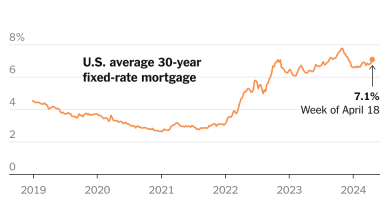The Fed warns of social media ‘echo chambers’ that pump up meme stocks.

Stocks that experience major volatility as a result of social media attention — often called meme stocks — have not threatened broader financial stability so far but could open the door to vulnerabilities, the Federal Reserve said in a new report.
The Fed’s twice-yearly update on America’s financial system included a special section on the meme stock phenomenon. It attributed the trend, in which attention on Twitter, Reddit and other platforms encourages rapid inflows into or out of buzzy stocks, to new trading technologies including mobile apps and to changing demographics, as younger people enter the retail trading market.
“Along with the rise in risk appetite and the growing share of younger retail investors, access to retail equity trading opportunities has expanded over the past decade,” the report said.
Social media can pump up interest in stocks, and it can also create an echo chamber, one in which “investors find themselves communicating most frequently with others with similar interests and views, thereby reinforcing their views, even if these views are speculative or biased.”
Still, internet-inspired pile-ons do not necessarily create conditions that will spur a broad market crash, the Fed’s report suggested.
“To date, the broad financial stability implications of changes in retail equity investor characteristics and behaviors have been limited,” the Fed said. The central bank specifically assessed what happened to shares of AMC Entertainment and GameStop in January, noting that activity and volatility in those stocks came alongside high activity on Twitter.
While the report concluded that “recent episodes of meme stock volatility did not leave a lasting imprint on broader markets,” the Fed said a few trends “should be monitored.”
The report pointed out that young and debt-laden investors may be more vulnerable to stock price swings, especially since they are now using “options,” which allow traders to place bets on whether prices will rise or fall and which can magnify leverage and potential losses.
The Fed also warned that “episodes of heightened risk appetite may continue to evolve with the interaction between social media and retail investors and may be difficult to predict,” and that financial firms may not have calibrated their risk-management systems to reflect the volatility and losses that meme stock episodes might trigger.
“More frequent episodes of higher volatility may require further steps to ensure the resilience of the financial system,” it said.
Looking across a broader range of asset classes and recent trading activity, the Fed’s financial stability analysis generally suggested that the vulnerabilities have moderated compared with earlier in the pandemic — but it did flag high asset prices and a number of lingering risks.
Stock prices have increased “notably,” the report said, and prices relative to forecast earnings remain near historical highs. Home prices have climbed, it noted, though mortgage lending standards have not deteriorated too badly. When lenders start to lower their standards, that can make the market more vulnerable.
The Fed noted that “corporate bond issuance remained robust, supported by low interest rates,” also pointing out that “across the ratings spectrum, the composition of newly issued corporate bonds has become riskier.”
And while many markets show signs of investor optimism, some lingering financial strains from the pandemic shock persist.
Some commercial real estate sectors continue to face challenges because “office vacancies are elevated and hotel occupancy rates remain depressed,” the report noted. Plus, “structural vulnerabilities persist in some types of money market funds,” which could amplify a future shock to the system.
Money market mutual funds melted down during the pandemic and required a Fed rescue for the second time in a dozen years, and regulators are now looking at how to reform them to make them more resilient.
The report also warned that life insurers might struggle to raise cash in a pinch.
And it delved into climate risks. The central bank is among regulators now trying to understand what risks climate change might pose to banks, insurers and the broader financial system.
“The Federal Reserve is developing a program of climate-related scenario analysis,” the report noted. “The Federal Reserve considers an effective scenario analysis program, which is designed to be forward looking over a period of years or decades, to be separate from its existing regulatory stress-testing regime.”




